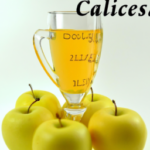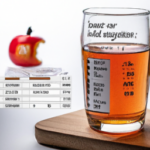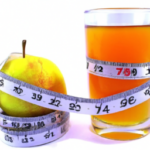Juice Tips and Tricks
How Many Calories Are In A Cup Of Apple Juice

As someone who values health and closely monitors their nutritional intake, I often wonder about the nutritional value of the food and drinks I consume. Apple juice is a popular beverage known for its tasty flavor and perceived health benefits. If you are like me, you may be curious about the calories in a cup of apple juice and how it fits into a balanced diet.
In this article, I will explore the calorie content of apple juice and provide information on factors that can affect its nutritional value. I will also offer tips on how to incorporate apple juice into a healthy diet and discuss potential risks of consuming too much.
By the end of this article, you will have a better understanding of the role that apple juice can play in your overall nutrition and be equipped with the knowledge to make informed choices about what you consume.
Key Takeaways
- A cup of apple juice contains around 120 calories and is a good source of vitamin C, potassium, and antioxidants.
- Apple juice is high in sugar and lacks fiber, which can lead to blood sugar spikes and cravings for more sweet drinks or snacks.
- Serving size plays a big role in calorie intake, and apple juice should be consumed in moderation.
- Choosing a juice made from 100% pure apple juice, without any added sweeteners or preservatives, is important.
The Nutritional Value of Apple Juice
You’re probably wondering about the nutritional value of that delicious cup of apple juice in your hand, and let me tell you, it packs a punch with around 120 calories per cup.
But it’s not just about the calories – apple juice is a good source of vitamin C, potassium, and antioxidants, which can provide potential benefits for overall health.
However, it’s important to note that apple juice does have some drawbacks for overall health. While it can be a tasty way to stay hydrated, it’s also high in sugar and lacks the fiber found in whole apples. This can lead to blood sugar spikes and cravings for more sweet drinks or snacks.
So, while apple juice can be a part of a balanced diet, it should be consumed in moderation.
Moving on to the calorie content of apple juice, it’s important to understand how these calories may impact your overall health and wellness.
The Calorie Content of Apple Juice
When it comes to apple juice, knowing the calorie content is essential for maintaining a healthy diet. One important factor to consider is the serving size, as this will affect the overall calorie count.
It’s also helpful to compare the calorie content of apple juice to other beverages, such as soda or water, to make informed choices.
To accurately calculate the number of calories in a serving of apple juice, it’s important to know the nutritional information and how to use it.
Serving Size
If you’re planning on drinking apple juice, make sure to pay attention to the serving size listed on the label so you don’t end up accidentally consuming too many calories. Measuring accuracy is crucial in determining the right amount of apple juice to consume.
A standard serving size of apple juice is 8 fluid ounces or 240 milliliters, which contains about 120 calories. However, some brands may have different serving sizes or calorie content, so it’s important to read the label carefully.
Aside from being a refreshing beverage, apple juice also offers nutritional benefits. It contains vitamins C and B6, as well as potassium and antioxidants that help boost the immune system and protect the body from harmful free radicals. However, it’s important to consume apple juice in moderation to avoid consuming too many calories and sugar.
With that said, let’s move on to comparing apple juice to other beverages.
Comparing to Other Beverages
Take a moment to consider the nutritional value of the beverages you consume and how they compare to apple juice. When it comes to comparing nutritional value, one common comparison is apple juice vs. soda. While apple juice may seem like a healthier option than soda, it still contains a significant amount of calories.
To give you a better idea, let’s take a look at a comparison table of the nutritional value of apple juice and soda.
| Beverage | Serving Size (8 oz) | Calories |
|---|---|---|
| Apple Juice | 1 cup | 114 |
| Regular Soda | 1 can | 150 |
| Diet Soda | 1 can | 0 |
| Water | 1 cup | 0 |
As you can see, apple juice contains fewer calories than regular soda, but it is still a significant amount. Additionally, it’s important to note that serving size plays a big role in calorie intake. When it comes to apple juice, a 1 cup serving contains 114 calories, but it’s common for people to consume more than 1 cup at a time, which can significantly increase calorie intake.
Now that we have compared the nutritional value of apple juice to other beverages, let’s move on to how to calculate calories.
How to Calculate Calories
Get ready to learn how to easily figure out the number of calories in your favorite beverages. Calorie counting is essential when it comes to maintaining a healthy diet and achieving fitness goals. It helps you understand the macronutrient breakdown of your food and drink intake and makes it easier to keep track of your daily calorie intake.
To calculate the number of calories in a cup of apple juice, you need to know the macronutrient breakdown of the drink. The macronutrient breakdown of apple juice includes carbohydrates, protein, and fat. However, as apple juice is mostly made up of carbohydrates, we can assume that the calorie count mainly comes from the carbohydrates present in the drink.
Understanding how to calculate the calorie content of your favorite beverages is essential for maintaining a healthy diet. It helps you keep track of your daily calorie intake and ensures that you’re getting the right macronutrient breakdown.
In the next section, we’ll explore the factors that affect the calorie content of apple juice, giving you a better understanding of the drink’s nutritional value.
Factors That Affect Calorie Content
When it comes to the calorie content of apple juice, there are a few factors that can have a significant impact. One of the biggest culprits is added sugars. Many brands of apple juice contain high amounts of added sugars, which can significantly increase the calorie count.
Additionally, the processing method used to make the juice can also affect its calorie content, as can the brand and overall quality of the product.
Added Sugars
You may be surprised to learn that a cup of apple juice can contain a significant amount of added sugars. While apple juice is naturally sweet due to the fructose content, some manufacturers add additional sugars to enhance the flavor and extend the shelf life of the product. These added sugars can increase the calorie count of a cup of apple juice.
Consuming excessive amounts of added sugars can have significant health implications, including an increased risk of developing obesity, type 2 diabetes, and heart disease. The recommended daily intake of added sugars for women is 6 teaspoons or 24 grams, while for men it is 9 teaspoons or 36 grams.
Therefore, it’s important to check the nutrition label of apple juice before consuming to ensure you’re not exceeding your daily intake of added sugars. Moving forward, let’s take a look at how processing methods can affect the calorie content of apple juice.
Processing Methods
One thing to consider is how apple juice is processed – did you know that the method used can affect its overall nutrition value? When it comes to juice processing, there are various preservation methods that can be applied to extend the product’s shelf life.
For instance, some manufacturers use pasteurization, which involves heating the juice to a high temperature to kill off any bacteria or pathogens that may be present. While this method ensures the safety of the juice, it can also reduce its nutritional content, particularly its vitamin C levels.
On the other hand, some brands opt for cold-pressed juices, which involve using a hydraulic press to extract juice from fruits without applying heat. This method results in a juice that’s richer in nutrients and enzymes, but it’s also more expensive and has a shorter shelf life.
Another option is flash pasteurization, which involves heating the juice for a shorter time than regular pasteurization. This method helps retain more of the juice’s natural flavor and nutrition, but it’s still not as beneficial as raw, unprocessed juice.
By understanding the different juice processing methods, you can make an informed decision about the type of apple juice you want to incorporate into your diet.
When it comes to choosing the right brand and quality of apple juice, there are several factors to consider. One of the most important things to look for is a juice that’s made from 100% pure apple juice, without any added sweeteners or preservatives.
Additionally, you may want to consider the juice’s packaging – glass bottles are a better option than plastic as they don’t leach harmful chemicals into the juice. By being mindful of these factors, you can choose an apple juice that not only tastes great but also supports your overall health and well-being.
Brand and Quality
If you want to enjoy a delicious and nutritious glass of apple juice, it’s important to choose a brand that uses 100% pure apple juice without any added sweeteners or preservatives. When comparing brands, it’s important to read the label carefully to ensure that the juice is not made from concentrate, which can contain added sugar and water.
Additionally, the quality of the apples used in the juice can affect the taste and nutrition content. Look for brands that use fresh, ripe apples that have been harvested at their peak. Juice extraction methods can also impact the quality and nutrition content of apple juice.
Cold-pressed methods are preferred, as they retain more of the nutrients and natural flavors of the apples. On the other hand, heat pasteurization can destroy some of the beneficial enzymes and vitamins present in the juice. Ultimately, choosing a high-quality brand and extraction method can ensure that you’re getting the most nutrition and flavor out of your cup of apple juice.
Now, let’s explore how to incorporate apple juice into a healthy diet.
How to Incorporate Apple Juice into a Healthy Diet
When it comes to incorporating apple juice into a healthy diet, there are a few key points to keep in mind. First and foremost, moderation and portion control are crucial. While apple juice can be a healthy addition to your diet, it’s important not to overdo it, as excessive consumption can lead to a high intake of sugar and calories.
Additionally, pairing apple juice with other healthy foods, like whole grains and lean protein, can help balance out your overall nutrient intake. And finally, if you’re looking for alternatives to apple juice, there are plenty of other nutritious options out there, like vegetable juices or herbal teas.
Moderation and Portion Control
To maintain a healthy diet, it’s important to be mindful of how much apple juice you consume and practice portion control. While apple juice can provide valuable nutrients such as vitamin C and potassium, it’s also high in sugar and calories.
The American Heart Association recommends limiting added sugars to no more than 6 teaspoons per day for women and 9 teaspoons per day for men. A cup of apple juice contains about 24 grams of sugar, which is equivalent to 6 teaspoons of sugar.
Portion sizes and frequency of consumption are key factors to consider when incorporating apple juice into your diet. One cup of apple juice is considered a serving size, and it’s recommended to consume no more than 1-2 servings per day.
It’s also important to consider the overall amount of sugar and calories in your diet, as well as balancing it with other nutritious foods. In the next section, we’ll explore how to pair apple juice with other foods to create a balanced and healthy meal.
Pairing with Other Foods
Pairing apple juice with complementary foods can create a well-rounded and satisfying meal. Not only does apple juice offer a sweet and refreshing flavor, but it also has several health benefits. When paired with certain foods, these benefits can be enhanced and the overall taste experience can be elevated.
One great pairing option is with a protein-rich breakfast such as scrambled eggs or a breakfast sandwich. Apples contain pectin, a type of soluble fiber that can help regulate blood sugar levels and keep you feeling full longer. Combining apple juice with protein can also help stabilize blood sugar levels and provide sustained energy throughout the morning. Another great option is to pair apple juice with a savory salad that includes ingredients such as spinach, feta cheese, and walnuts. The tartness of the apple juice pairs well with the saltiness of the feta cheese and the crunch of the walnuts, while also providing an extra dose of vitamins and antioxidants.
While apple juice can be a great addition to a meal, there are also plenty of alternatives to consider. In the next section, we will explore some of the best options for those looking to switch up their juice game.
Alternatives to Apple Juice
If you’re looking to mix things up, why not try some of these tasty juice alternatives? While apple juice can be a delicious and refreshing beverage, it’s important to consider the amount of sugar and calories it contains. Luckily, there are plenty of healthy beverage options that can provide similar benefits without the added sugar.
One great option is fresh squeezed orange juice, which has a similar level of sweetness but contains fewer calories and less sugar than apple juice. Other alternatives include pomegranate juice, grapefruit juice, and cranberry juice, all of which offer unique health benefits such as antioxidant properties and potential protection against certain diseases.
By incorporating these alternatives into your diet, you can reap the benefits of reducing your sugar intake while still enjoying a refreshing and flavorful beverage.
As we’ve discussed, there are plenty of alternatives to apple juice that offer similar benefits without the added sugar. But if you’re not ready to give up apple juice altogether, there are still ways to reduce your calorie intake.
In the next section, we’ll explore some tips for making smarter choices when it comes to apple juice consumption.
Tips for Reducing Calorie Intake from Apple Juice
When it comes to reducing calorie intake from apple juice, I’ve found that diluting it with water is a great option. This not only cuts down on calories, but also helps me stay hydrated throughout the day.
Additionally, I always make sure to choose low-calorie options and carefully read the labels to ensure I’m making the healthiest choice possible.
By following these tips, I’m able to incorporate apple juice into my diet without compromising my health goals.
Diluting with Water
Mixing apple juice with water is a great way to dilute the calories and still enjoy a refreshing beverage. Not only does diluting your apple juice help you reduce your calorie intake, it also helps you stay hydrated and improves your digestion. Diluted apple juice is also an excellent source of vitamins and minerals, which help boost your immune system and keep you healthy.
When it comes to diluting your apple juice, it’s important to know the recommended ratios for dilution. The ideal ratio is one part apple juice to three parts water. This ratio allows you to enjoy the taste of apple juice without consuming too many calories. You can adjust the ratio to your liking, but make sure not to add too much water, as it may dilute the taste too much.
Choosing low-calorie options is another way to reduce your calorie intake from apple juice. By selecting low-calorie apple juice brands or making your own apple juice at home, you can enjoy the taste of apple juice without consuming too many calories. Additionally, adding fresh fruits and vegetables to your apple juice can help boost its nutritional value and add flavor without adding too many calories.
Choosing Low-Calorie Options
Opting for lower-cal options can be a great way to enjoy a delicious and healthier beverage. When it comes to apple juice, there are a few low sugar options available in the market. These low-calorie options are a great choice for those who are watching their calorie intake. They contain fewer calories than regular apple juice and are usually sweetened with natural sweeteners like Stevia instead of sugar.
It’s important to note that portion sizes also play a significant role in calorie intake. Even if you choose a low-calorie apple juice, consuming too much of it can still result in a high calorie intake. Therefore, it’s important to always check the serving size and limit your consumption accordingly.
With this in mind, opting for low-calorie options and being mindful of portion sizes can help you enjoy a refreshing cup of apple juice without compromising your calorie intake. When it comes to choosing a low-calorie option, reading labels is an important step.
Reading Labels
Before you make your purchase, take a moment to read the label and make an informed decision about the ingredients in your drink. Interpreting labels can be a daunting task, but it’s essential to understanding what you’re consuming.
Apple juice may seem like a healthy option, but it can be high in sugar and calories. When reading the label, it’s important to look at the serving size and the amount of sugar and calories per serving.
Understanding measurements is also crucial when interpreting labels. For example, a cup of apple juice contains approximately 120 calories and 28 grams of sugar. This may not seem like a lot, but if you drink multiple cups a day, the calories and sugar can add up quickly. Additionally, some brands may add extra sugar or preservatives, so it’s essential to read the label carefully.
By being mindful of the information on the label, you can make an informed choice about the apple juice you consume and its impact on your overall diet.
Transitioning into the subsequent section, it’s important to note that while apple juice can be a part of a healthy diet, it should be consumed in moderation. The role of apple juice in your overall diet is to provide vitamins, minerals, and antioxidants. However, it should not be a replacement for whole fruits, which provide fiber and other essential nutrients.
Incorporating apple juice as a part of a balanced diet can be a healthy choice, but it should not be the sole source of fruit in your diet.
The Role of Apple Juice in Your Overall Diet
You may not realize it, but incorporating apple juice into your diet can have a significant impact on your overall health and well-being. Here are some benefits and drawbacks to consider:
- Apple juice contains antioxidants, which can help reduce the risk of chronic diseases.
- Drinking apple juice can also improve hydration levels, as it contains water and electrolytes.
However, apple juice is high in sugar and calories, which can lead to weight gain and other health issues if consumed in excess.
It’s important to be mindful of how much apple juice you consume and to balance it with other healthy foods and drinks. In the next section, we’ll explore potential risks of consuming too much apple juice and how to avoid them.
Potential Risks of Consuming Too Much Apple Juice
As we discussed earlier, apple juice can be a healthy addition to your overall diet. However, it’s important to be mindful of how much you consume as excessive intake can have potential health effects.
While apple juice is a good source of vitamins and minerals, it’s also high in sugar and calories. Drinking large amounts on a regular basis may contribute to weight gain, tooth decay, and even an increased risk of type 2 diabetes. The recommended daily intake for apple juice is no more than one cup (8 ounces) for children and two cups (16 ounces) for adults.
It’s also important to note that whole apples are a better option as they contain fiber, which helps to slow down the absorption of sugar and keep you feeling full for longer. By being mindful of your apple juice intake and choosing whole apples more often, you can still enjoy the benefits of this fruit while avoiding potential risks.
When considering the nutritional information of apple juice, it’s important to also take into account other factors such as added sugars and preservatives. Let’s explore this further in the next section.
Other Nutritional Information to Consider
When it comes to apple juice, there’s more to consider than just the calorie count. I found that apple juice contains fiber, which can aid digestion and promote feelings of fullness. Additionally, it’s rich in antioxidants, which may help protect your cells from damage caused by free radicals.
However, it’s important to note that some individuals may have allergies or sensitivities to certain components of apple juice, such as the natural sugars or preservatives.
Fiber Content
Did you know that a cup of apple juice contains only 0.5 grams of fiber, which is less than 2% of the recommended daily value?
Juice processing involves fiber extraction, where the pulp and skin of the apple are removed, leaving only the juice. This removal of fiber also removes some of the beneficial nutrients found in the apple, including antioxidants.
Although apple juice is not a significant source of dietary fiber, it still provides other important nutrients such as vitamin C and potassium. Additionally, apples contain antioxidants that help protect the body from damage caused by free radicals. These antioxidants are still present in apple juice, albeit in smaller amounts than in whole apples.
Incorporating a variety of fruits and vegetables, including apples and their juice, into your diet can help you achieve a well-rounded and nutritious diet.
Antioxidants
You’ll be glad to know that antioxidants, which are beneficial for protecting your body from free radicals, can still be found in apple juice despite the removal of fiber during processing. Antioxidants are molecules that can neutralize harmful compounds in your body, such as reactive oxygen species, which can cause cellular damage and contribute to the development of chronic diseases.
Apple juice contains several types of antioxidants, including flavonoids, phenolic acids, and carotenoids, which can provide various health benefits. Here are some sources that explain the health benefits of antioxidants in apple juice:
- A study published in the Journal of Agricultural and Food Chemistry found that drinking apple juice may increase the antioxidant activity in your blood, which can reduce the risk of oxidative stress-related diseases.
- Another study published in the same journal suggested that the polyphenols in apple juice may have anti-inflammatory and anti-cancer effects.
- According to the United States Department of Agriculture (USDA), a cup of unsweetened apple juice provides about 5% of the daily value for vitamin C, which is another antioxidant that can boost your immune system and improve skin health.
Moving on to the next section about allergies and sensitivities, it’s important to note that apple juice may cause allergic reactions in some individuals.
Allergies and Sensitivities
Hold on to your taste buds, folks, because for some unlucky individuals, apple juice can trigger an allergic reaction or sensitivity. Common allergies to apples include oral allergy syndrome (OAS), which causes itching and swelling in the mouth, throat, and lips, as well as hives, itching, and anaphylaxis. Sensitivity symptoms may include bloating, diarrhea, and abdominal pain. These reactions are caused by proteins in apples, which can be found in higher concentrations in juice than in whole apples.
If you suspect you may have an allergy or sensitivity to apples or apple juice, it is important to speak with your healthcare provider. They may recommend an allergy test and advise you on how to manage symptoms. Some people with a sensitivity to apples may be able to tolerate small amounts, while others may need to avoid them altogether. Remember to always read labels and ask about ingredients when dining out or purchasing packaged foods.
Now, let’s talk about the importance of variety in your diet.
The Importance of Variety in Your Diet
Adding a variety of fruits and vegetables to your diet not only provides essential nutrients, but it also makes your meals more colorful and enjoyable. Exploring alternatives and finding balance is key to maintaining a healthy and interesting diet.
Here are three reasons why adding variety to your meals is important:
-
Nutrient Diversity: Each fruit and vegetable offers a unique set of nutrients. By incorporating a variety of produce into your diet, you ensure that your body is receiving a wide range of essential vitamins and minerals. Eating a rainbow of fruits and vegetables can also help reduce the risk of chronic diseases and improve overall health.
-
Flavorful Meals: Eating the same meals every day can quickly become boring. Adding variety to your diet can make meals more enjoyable and exciting. Trying new fruits and vegetables can introduce new flavors and textures to your palate. It can also help you discover new recipes and cooking techniques.
-
Sustainable Eating: Incorporating a variety of fruits and vegetables into your diet can also have a positive impact on the environment. Eating seasonally and locally sourced produce can reduce the carbon footprint of your meals. It can also support local farmers and promote sustainable agriculture practices.
Overall, adding variety to your diet can have numerous benefits for both your health and the environment. Exploring alternatives and finding balance is key to maintaining a long-term sustainable diet.
Frequently Asked Questions
Can apple juice be substituted for whole apples in a healthy diet?
As someone who prioritizes healthy eating, I’ve found that apple juice alternatives are plentiful. However, it’s important to note that the nutritional value of whole apples far surpasses that of juice. Opting for the whole fruit is always the better choice.
Is there a difference in calorie content between store-bought and homemade apple juice?
I prefer homemade apple juice for its higher juice quality and taste preference, but both store-bought and homemade options have similar calorie content. However, added sugars in store-bought juice may increase calories and impact overall health.
How does the calorie content of apple juice compare to other fruit juices?
After a nutritional comparison, apple juice has similar calorie content to other fruit juices. However, sugar content analysis shows that apple juice has higher amounts of natural sugars compared to some other juices.
Does the method of juicing affect the nutritional value of apple juice?
Juicing methods can affect the nutrient retention in apple juice. High-pressure processing and cold-pressed methods retain more nutrients compared to traditional methods. Nutrients like vitamin C, antioxidants, and polyphenols are more abundant in freshly squeezed juice.
Are there any potential health benefits to consuming apple juice beyond its nutritional value?
As I researched, I found potential benefits to consuming apple juice beyond its nutritional value. Research findings suggest it may aid digestion, improve brain function, and lower the risk of certain diseases.
Conclusion
In conclusion, apple juice can be a healthy addition to your diet when consumed in moderation. It provides important nutrients such as vitamin C and potassium, with an average of 114 calories per cup.
However, it’s important to be mindful of added sugars and not rely solely on apple juice as a source of fruit in your diet. One interesting statistic to consider is that while apple juice is a popular choice among children, it can contribute to excessive calorie intake.
In fact, a study found that children who drank apple juice consumed an average of 20% more calories per day compared to those who did not consume any juice. This highlights the importance of moderation and variety in a healthy diet.
By incorporating a variety of fruits and limiting added sugars, apple juice can be a tasty and nutritious option.
Susannah expertise lies in researching and compiling evidence-based content on juicing, nutrition, and overall health. She is committed to ensuring that The Juicery World offers accurate, up-to-date, and trustworthy information to empower readers to take control of their health. Susannah’s goal is to inspire individuals to embrace juicing as a way to nourish their bodies and live their best lives.
Juice Tips and Tricks
How to Make Aloe Vera Juice Taste Better

Tired of the strong flavor of aloe vera juice? No problem, we’ve got the answer for you.
In this article, we’ll share some tips and tricks to make your aloe vera juice taste better. We have tried and tested various methods to enhance the flavor without compromising the health benefits.
From choosing the right juice to adding natural sweeteners and infusing with fruits and herbs, we’ve got all the information you need to transform your aloe vera juice into a delightful and refreshing beverage.
Let’s dive in!
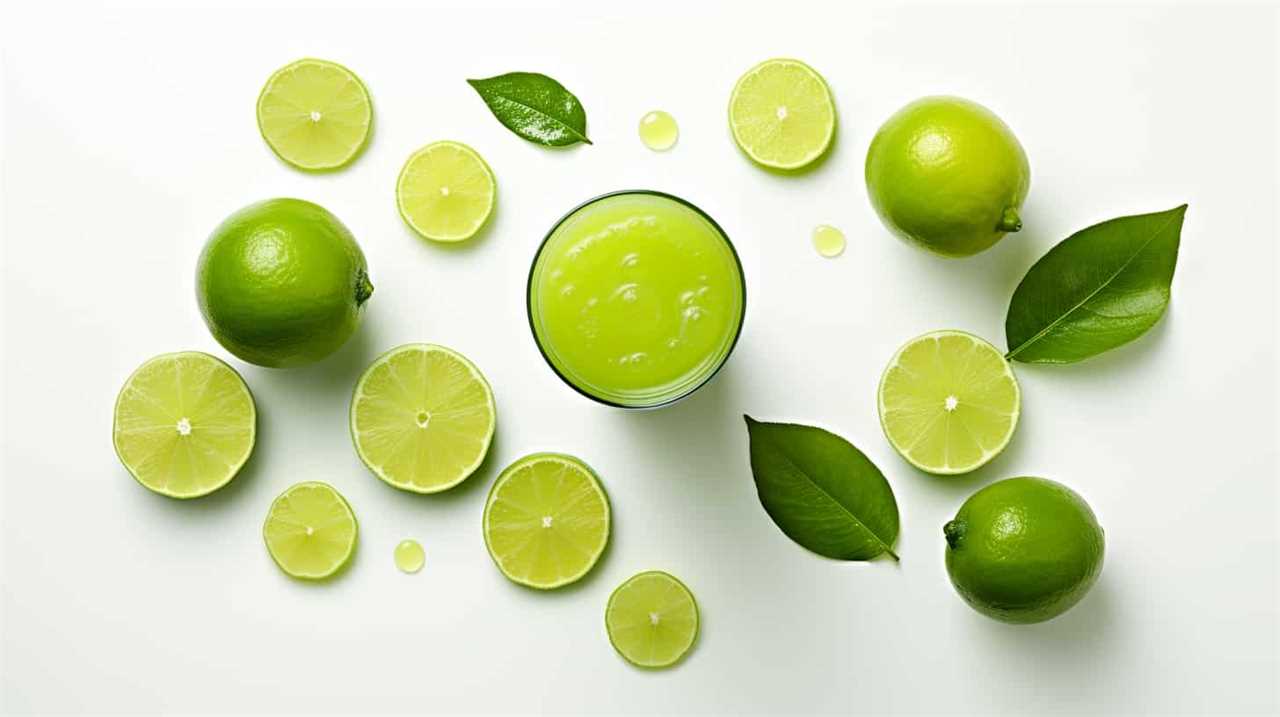
Key Takeaways
- Choose a reputable brand of aloe vera juice that prioritizes quality and uses organic, pure aloe vera.
- Avoid brands that contain added sugars or artificial ingredients.
- Use natural sweeteners like honey, agave syrup, or stevia to enhance the taste of aloe vera juice.
- Experiment with adding fruits, herbs, and other juices to create unique flavor combinations and enhance the health benefits of aloe vera juice.
Choosing the Right Aloe Vera Juice
We can enhance our experience with aloe vera juice by selecting the right brand and type for our preferences. When it comes to finding a reputable brand, it’s important to do some research and read reviews from other consumers. Look for brands that prioritize quality and use organic, pure aloe vera without any added sugars or artificial ingredients. Understanding the health benefits of aloe vera juice is also crucial in making the right choice. Aloe vera is known for its soothing properties, aiding digestion, promoting skin health, and boosting the immune system. By choosing a high-quality brand, we can ensure that we’re getting the maximum benefits from our aloe vera juice.
Now that we know how to choose the right brand, let’s move on to the next step of adding natural sweeteners.
Adding Natural Sweeteners
To enhance the flavor of our aloe vera juice, we can add natural sweeteners such as honey or agave syrup. Using alternative sweeteners not only adds sweetness but also brings unique flavors to the juice. Here are some options to consider:
- Stevia: A natural sweetener derived from the Stevia plant, it’s a zero-calorie alternative to sugar.
- Maple Syrup: This natural sweetener adds a rich and earthy flavor to the aloe vera juice.
- Dates: Pureed dates can be used to sweeten the juice while also providing essential nutrients like fiber.
In addition to using alternative sweeteners, we can enhance the flavor of aloe vera juice by adding spices and extracts. Cinnamon, ginger, or vanilla extract can add warmth and depth to the taste. By experimenting with different combinations of these natural sweeteners, spices, and extracts, we can create a flavor profile that suits our preferences.

Now, let’s move on to the next section and learn how to infuse aloe vera juice with fruits and herbs to further enhance its taste.
Infusing With Fruits and Herbs
As we explore ways to make our aloe vera juice taste better, one option to consider is infusing it with fruits and herbs. Creating unique aloe vera blends by adding fruits and herbs not only enhances the flavor but also adds a touch of freshness and complexity to the juice.
Fruits like strawberries, pineapple, or citrus can add a burst of sweetness, while herbs like mint, basil, or ginger can provide a subtle yet refreshing twist. Exploring the benefits of herbal infusions can also be beneficial for our health. For example, adding a few sprigs of lavender can promote relaxation and reduce stress. Additionally, infusing aloe vera juice with rosemary can aid digestion and boost the immune system.
Blending With Other Juices
Let’s try mixing aloe vera juice with different fruit juices to create delicious and refreshing blends. Blending aloe vera juice with other fruits not only enhances its taste but also adds nutritional benefits to your drink. Here are three fruit juices that you can mix with aloe vera juice:

- Orange juice: Combining aloe vera juice with orange juice not only adds a tangy flavor but also boosts your intake of vitamin C, which is essential for a strong immune system.
- Pineapple juice: Mixing aloe vera juice with pineapple juice creates a tropical blend that isn’t only refreshing but also helps in digestion. Pineapple contains bromelain, an enzyme that aids in breaking down proteins and promoting better digestion.
- Watermelon juice: Blending aloe vera juice with watermelon juice creates a hydrating and refreshing combination. Watermelon is rich in water content and contains electrolytes that can help replenish your body’s fluids.
Experimenting With Flavor Combinations
While we can try various flavor combinations with aloe vera juice, it’s important to find the right balance to enhance its taste. Experimenting with different flavors can’t only make the juice more enjoyable but also enhance its health benefits.
Aloe vera juice is known for its numerous health benefits, such as boosting digestion, promoting hydration, and supporting the immune system. By adding complementary flavors, we can create a refreshing summer drink that not only tastes great but also provides a nutritional boost.
Some popular flavor combinations include mixing aloe vera juice with citrus fruits like lemon or orange, adding a splash of coconut water for a tropical twist, or combining it with cucumber and mint for a refreshing and cooling effect.
Don’t be afraid to get creative and find the flavor combination that suits your taste buds best!

Frequently Asked Questions
Can I Use Store-Bought Aloe Vera Gel Instead of Fresh Aloe Vera for Making Juice?
Yes, you can use store-bought aloe vera gel instead of fresh aloe vera for making juice. However, it’s important to note that fresh aloe vera juice may have more health benefits due to its higher nutrient content.
How Long Can I Store Aloe Vera Juice in the Refrigerator?
Aloe vera juice can be stored in the refrigerator for up to a week. Refrigeration helps maintain the longevity and freshness of the juice, preserving its beneficial properties.
Can Aloe Vera Juice Help With Digestive Issues?
Aloe vera juice can potentially help with digestive issues when taken in appropriate dosages. However, it is important to note that there may be potential side effects. It is always best to consult with a healthcare professional before starting any new supplement regimen.
Can I Use Artificial Sweeteners Instead of Natural Sweeteners in My Aloe Vera Juice?
Using artificial sweeteners in aloe vera juice may affect its taste and potential health benefits. However, natural sweeteners like honey or stevia can enhance the flavor without compromising its nutritional value.

Is It Safe to Drink Aloe Vera Juice Every Day?
Drinking aloe vera juice daily can have numerous benefits, such as improving digestion and boosting the immune system. However, consuming it regularly may also lead to potential side effects like diarrhea or stomach cramps.
Conclusion
In conclusion, making aloe vera juice taste better is easy and enjoyable.
By choosing the right aloe vera juice and adding natural sweeteners, infusing with fruits and herbs, blending with other juices, and experimenting with flavor combinations, you can create a delightful and refreshing drink.
So go ahead and unleash your creativity in the kitchen, and transform your aloe vera juice into a sensational elixir that will transport your taste buds to paradise.

Susannah expertise lies in researching and compiling evidence-based content on juicing, nutrition, and overall health. She is committed to ensuring that The Juicery World offers accurate, up-to-date, and trustworthy information to empower readers to take control of their health. Susannah’s goal is to inspire individuals to embrace juicing as a way to nourish their bodies and live their best lives.
Juice Tips and Tricks
How to Make a Glass of Lemonade With Bottled Lemon Juice

Are you craving a cool glass of lemonade to quench your thirst? Look no further! Try out our perfect recipe using bottled lemon juice that will surely please your taste buds.
In this article, we’ll guide you through the process of creating a tangy and sweet concoction that will leave you feeling refreshed and satisfied.
So grab your ingredients and let’s get started on this delightful journey of serving ourselves and others a glass of pure lemony goodness.
Key Takeaways
- Consider the storage of the bottled lemon juice (dark glass or plastic bottles, protect from light exposure, check expiration date)
- Choose a suitable pitcher and fresh lemons for enhanced flavor
- Store the lemonade concentrate in the refrigerator to maintain freshness
- Adjust the sweetness and tartness to taste with sugar or more lemon juice, and experiment with different sweeteners or additional flavors.
Choosing the Right Bottled Lemon Juice
What are the key factors we should consider when selecting the right bottled lemon juice for our lemonade?

One important factor is how the lemon juice is stored. Look for bottles that are made of dark glass or plastic, as they help protect the juice from light exposure, which can degrade its quality. It’s also important to check the expiration date to ensure freshness.
Another benefit of using bottled lemon juice is convenience. It saves time and effort compared to squeezing fresh lemons. Additionally, bottled lemon juice provides consistent flavor, as the acidity levels are standardized.
When selecting a brand, consider reading reviews and checking for certifications, such as organic or non-GMO.
Gathering the Necessary Ingredients and Tools
How can we gather all the necessary ingredients and tools to make a glass of lemonade with bottled lemon juice?
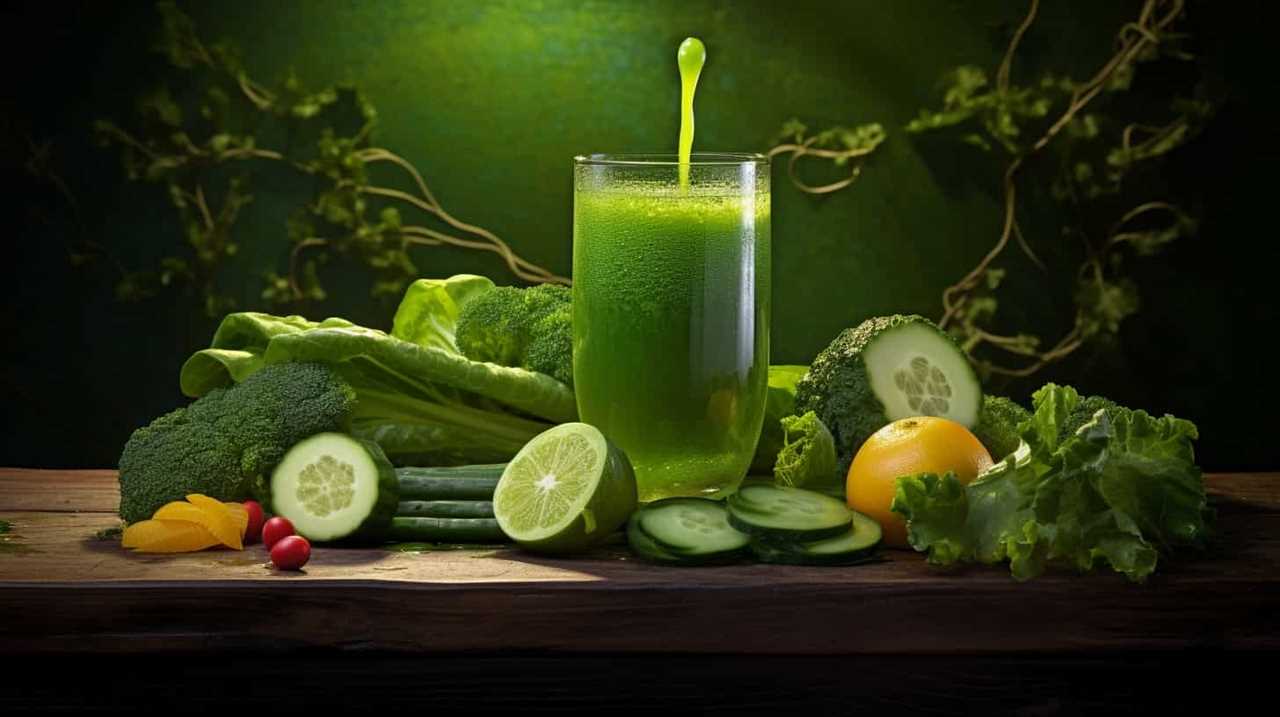
It’s important to start with the right pitcher. Look for a pitcher that’s made of glass or BPA-free plastic, as these materials won’t affect the taste of the lemonade. The pitcher should also have a lid or cover to keep the lemonade fresh and prevent spills.
Now, let’s talk about the lemons. While bottled lemon juice is convenient, using fresh lemons instead can elevate the flavor of your lemonade. Choose lemons that are firm and have a bright yellow color. Give them a gentle squeeze to ensure they’re juicy. To extract the juice, you’ll need a citrus juicer or a reamer. These tools make it easy to get every last drop of juice from the lemons.
Mixing the Lemonade Concentrate
To start mixing the lemonade concentrate, we’ll slowly pour the bottled lemon juice into the pitcher. It’s important to choose the right container for the lemonade concentrate. A pitcher with a lid or a tightly sealed container will help maintain the freshness and prevent any spills or leaks. Once the lemon juice is in the pitcher, we can move on to the next step of adding water and sweetener.
To ensure the lemonade concentrate stays fresh, it’s essential to store it properly. Keep the pitcher in the refrigerator to maintain its cool temperature and prevent any bacteria growth. If you have any leftover concentrate, transfer it to a smaller container with an airtight lid before refrigerating. This will help retain its flavor and prevent any contamination.

Now that we’ve mixed the lemonade concentrate, it’s time to adjust the sweetness and tartness to taste.
Adjusting the Sweetness and Tartness to Taste
We can adjust the sweetness and tartness of the lemonade to taste by adding more sugar or lemon juice, respectively. If you prefer a sweeter lemonade, simply add more sugar and stir until it dissolves completely. You can experiment with different sweeteners such as honey or agave syrup to find the perfect balance of sweetness.
On the other hand, if you want a tangier lemonade, add more lemon juice gradually, tasting as you go until it reaches your desired level of tartness.
Additionally, you can get creative with your lemonade by adding flavors like fresh mint leaves or a hint of lavender. These additions can elevate the flavor profile and create a more refreshing and unique experience.

Now that we’ve adjusted the sweetness and tartness of our lemonade, let’s move on to serving and enjoying your refreshing glass of lemonade.
Serving and Enjoying Your Refreshing Glass of Lemonade
Now let’s sit back, relax, and savor our refreshing glass of lemonade.
When it comes to serving and enjoying this delightful drink, there are a few techniques and garnishing options to consider.
Firstly, serving your lemonade chilled is essential for maximum enjoyment. Ensure that you have chilled glasses or add ice cubes to the glasses before pouring the lemonade.

To add a touch of elegance, you can garnish your lemonade with a slice of lemon on the rim of the glass. For an extra burst of flavor, you could also add a sprig of fresh mint or a few berries.
Remember to gently stir the lemonade before serving to evenly distribute the flavors.
Now, take a sip, feel the refreshing tang of lemon, and let the sweet and tart flavors dance on your taste buds.
Cheers!
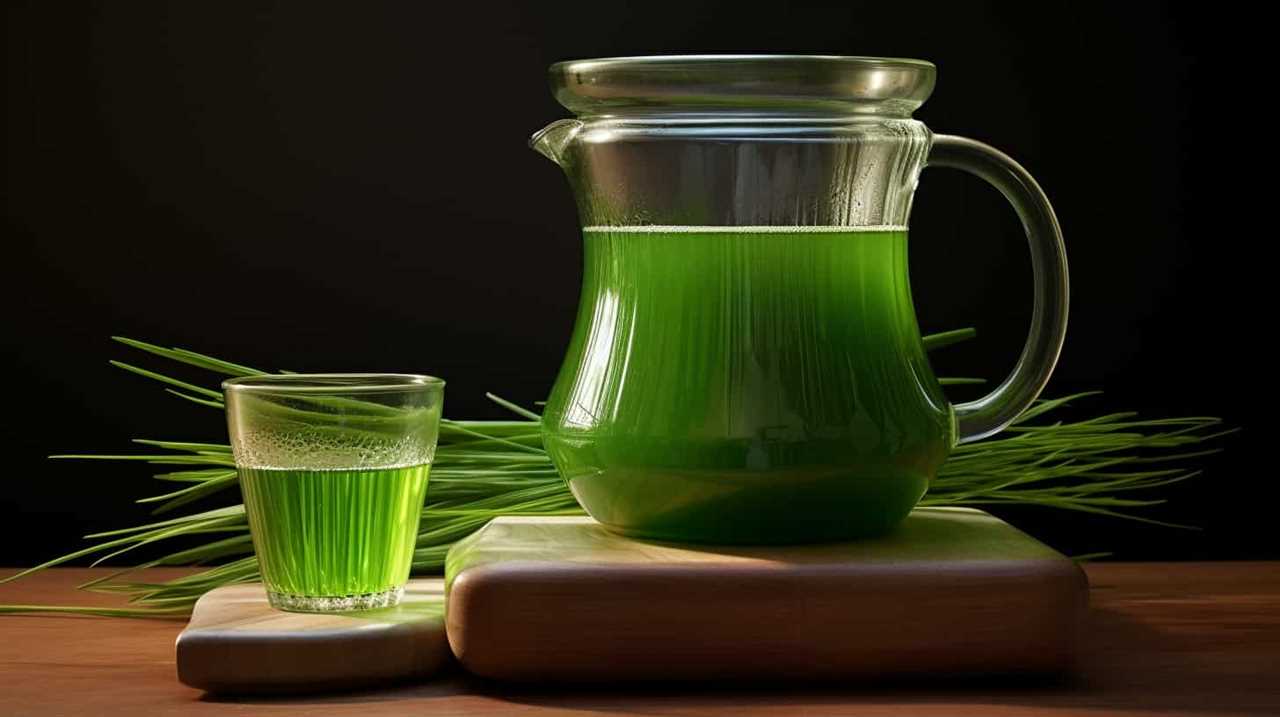
Frequently Asked Questions
Can I Use Fresh Lemons Instead of Bottled Lemon Juice?
Fresh lemons offer numerous benefits over bottled lemon juice. The taste of fresh lemons is unparalleled, providing a vibrant and tangy flavor. Incorporating fresh lemons into your lemonade will elevate its taste and give it a refreshing and authentic twist.
Can I Substitute Sugar With a Different Sweetener?
Substituting sweeteners in lemonade can enhance the flavor and offer health benefits. We’re knowledgeable about alternative sweeteners and can provide precise, detailed instructions on using them in place of sugar.
How Long Does the Lemonade Concentrate Need to Chill in the Refrigerator?
The chilling time for the lemonade concentrate in the refrigerator is typically around 1-2 hours. Using bottled lemon juice offers the benefit of convenience and consistent flavor for a refreshing glass of lemonade.
Can I Add Other Fruits or Flavors to the Lemonade?
Sure, we can definitely add different fruits or flavors to our lemonade. It’s a great way to experiment with unique flavors and create refreshing, personalized drinks. The possibilities are endless!

How Long Does the Lemonade Stay Fresh in the Refrigerator?
Lemonade made with bottled lemon juice can stay fresh in the refrigerator for about 5-7 days. To maximize shelf life, store it in an airtight container and keep it chilled.
Conclusion
And so, with a few simple steps and the right ingredients, a glass of refreshing lemonade is born.
Like a symphony of flavors dancing on your taste buds, this tangy elixir quenches thirst and brings joy on a hot summer day.
Just a sip transports you to a world of citrusy delight, where the sweetness and tartness blend harmoniously.

So go ahead, indulge in the art of lemonade-making and savor every drop of this sun-kissed nectar.
Cheers to the perfect glass of lemonade!
Susannah expertise lies in researching and compiling evidence-based content on juicing, nutrition, and overall health. She is committed to ensuring that The Juicery World offers accurate, up-to-date, and trustworthy information to empower readers to take control of their health. Susannah’s goal is to inspire individuals to embrace juicing as a way to nourish their bodies and live their best lives.
Juice Tips and Tricks
How to Know if Orange Juice Is Bad

We’ve all been in that situation before – reaching for a glass of orange juice and hesitating, unsure if it’s still okay to drink. Fear not! This article will give you the knowledge you need to determine for sure if your orange juice is still fresh or if it’s gone bad.
With a blend of scientific precision and practical tips, we’ll explore color changes, strange smells, off taste, texture changes, and mold or growth that may indicate spoilage.
Let’s dive in and serve ourselves a refreshing glass of certainty!
Key Takeaways
- Color changes in orange juice can indicate a loss of freshness and shelf life extension, but it doesn’t necessarily mean the juice is bad.
- Unusual or off-putting odors in orange juice, such as sour or fermented scents, can be a sign of poor quality.
- An off taste in orange juice, such as sour, bitter, or fermented flavors, suggests that the juice is spoiled.
- Texture changes in orange juice, such as pulp separation or a thicker consistency, can occur as the juice ages, so it’s important to consume it before the expiration date.
Color Changes in Orange Juice
We should be aware that color changes can indicate whether orange juice is bad.

When it comes to orange juice, color is a crucial factor to consider. As oranges are exposed to air, an oxidation process occurs, which leads to changes in color. Fresh orange juice has a vibrant orange hue, indicating its freshness and high nutritional value.
However, as time passes, the juice may undergo a color change, turning dull or brownish. This change in color is a result of the oxidation process, which affects the flavor and quality of the juice. It’s important to note that while a change in color doesn’t necessarily mean the juice is bad, it does indicate that the juice is losing its freshness and shelf life extension.
Therefore, it’s advisable to consume orange juice when it’s at its freshest, as indicated by its vibrant orange color.
Strange Smells in Orange Juice
When it comes to evaluating orange juice, we should be cautious of any strange smells or odors. A fresh, pleasant smell is indicative of good quality orange juice. However, if you notice any unusual or off-putting odors, it may be a sign that the juice has gone bad. These smells can range from a sour or fermented scent to a rancid or moldy aroma.

It’s important to note that while some natural variations in scent can occur due to the specific variety of oranges used, any strong or unpleasant smells should raise concerns. If you have citrus fruit allergies, it’s especially important to pay attention to the smell of orange juice, as it could indicate the presence of spoilage or contamination.
Ensuring the quality of orange juice is essential as it’s a popular beverage known for its health benefits, including being rich in vitamin C and antioxidants.
Off Taste of Orange Juice
Our taste buds can detect even the slightest hint of an off taste in orange juice, which can indicate that it has gone bad. The taste of orange juice should be fresh, tangy, and slightly sweet. If it tastes sour, bitter, or fermented, it’s likely spoiled.
One common cause of an off taste in orange juice is the use of overripe oranges. When oranges become overripe, their flavor profile changes, resulting in a less pleasant taste. Another factor to consider is the expiration date. Orange juice that has passed its expiration date is more likely to develop an off taste. It’s important to check the expiration date before consuming orange juice to ensure its freshness and quality.
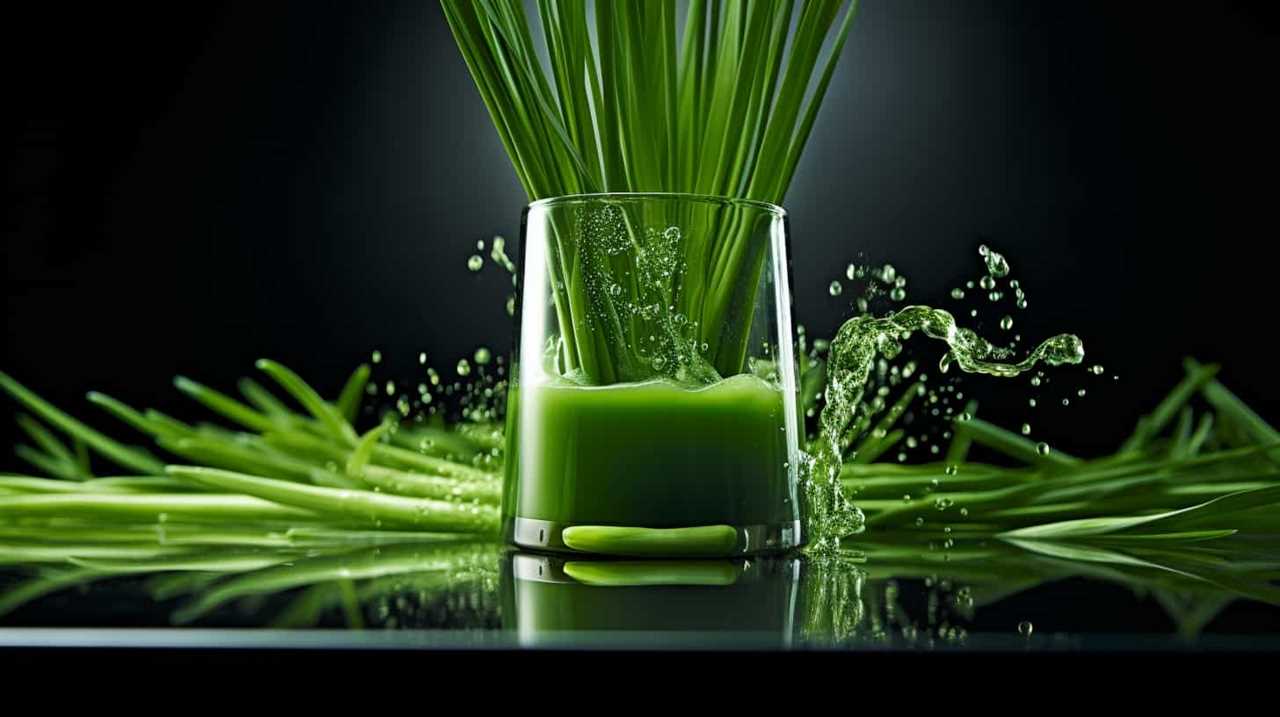
Now, let’s move on to discuss the texture changes in orange juice.
Texture Changes in Orange Juice
As we explore the texture changes in orange juice, it’s important to note that certain factors can cause it to become thicker or develop sediment. One common texture change in orange juice is pulp separation, where the pulp separates from the liquid and settles at the bottom. This can occur naturally over time, as the pulp particles become denser and sink.
Another factor that can affect the texture of orange juice is the expiration date. As orange juice ages, it may start to develop a thicker consistency and even form sediment. This is a result of the natural breakdown of the juice’s components. Therefore, it’s crucial to check the expiration date on orange juice and consume it before it reaches its expiration date to avoid any undesirable texture changes.
Mold or Growth in Orange Juice
We need to be aware of the possibility of mold or other growth occurring in orange juice. Mold can develop in orange juice if it isn’t stored properly or if it has passed its expiration date.

To prevent mold growth, it’s important to follow these steps:
- Store orange juice in the refrigerator at a temperature below 40°F (4°C).
- Check the expiration date on the bottle before consuming. Discard any orange juice that has expired.
- Keep the container tightly sealed to prevent air and moisture from entering, as these can promote mold growth.
Regularly inspecting orange juice for any signs of mold or unusual growth is essential. If you notice any discoloration, a strange odor, or visible mold, it’s best to discard the juice to avoid any potential health risks.
Frequently Asked Questions
Can Orange Juice Go Bad if It’s Stored in the Freezer for Too Long?
Frozen orange juice can potentially lose its nutrients and change its taste if stored in the freezer for too long. It is important to check for signs of spoilage before consuming it.
How Long Can Orange Juice Stay Fresh in the Refrigerator Once It’s Opened?
Once opened, orange juice can stay fresh in the refrigerator for about 7-10 days. To maintain its freshness, store it properly by keeping it tightly sealed and at a consistently cold temperature.
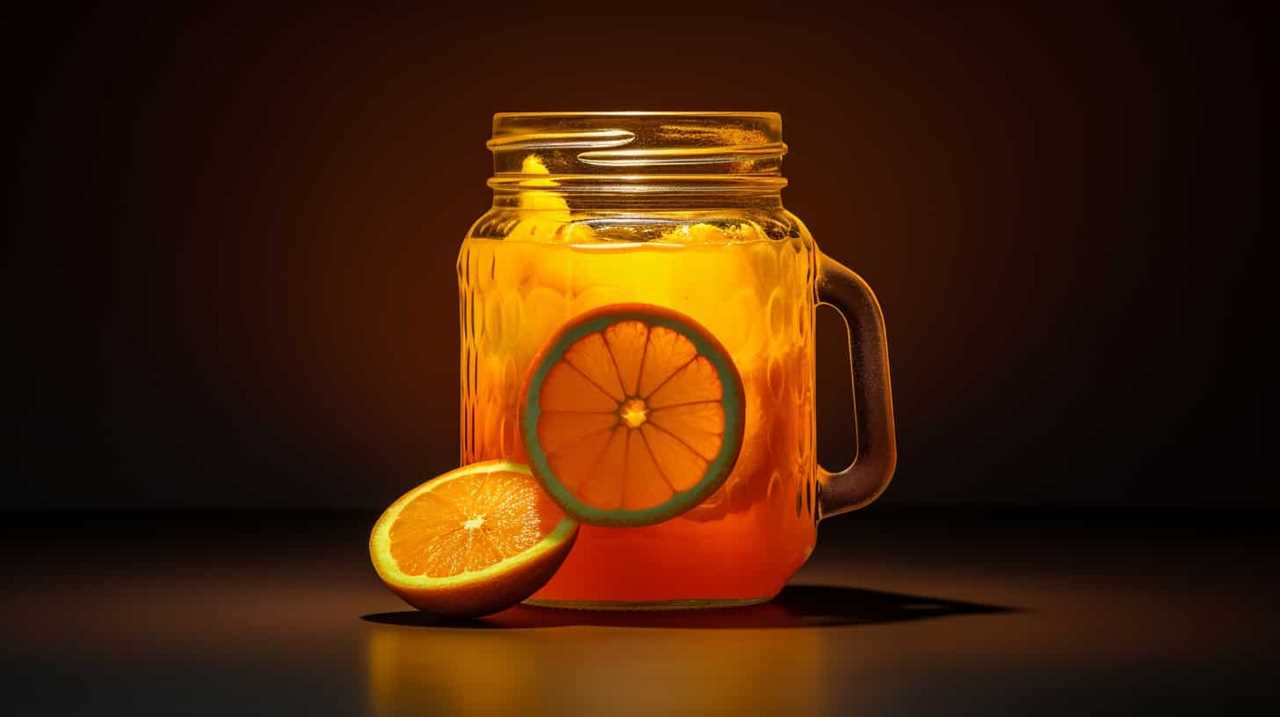
Is It Safe to Consume Orange Juice That Has Been Left Out at Room Temperature Overnight?
Left out orange juice may not be safe to drink as it can harbor harmful bacteria. Signs of spoiled orange juice include a sour smell, mold growth, and a change in color or taste.
Can Orange Juice Develop Harmful Bacteria if It’s Past Its Expiration Date but Still Looks and Smells Fine?
Orange juice can cause food poisoning if it develops harmful bacteria, even if it looks and smells fine. Signs of spoiled orange juice include a sour smell, mold growth, and a change in color or taste.
Does the Nutritional Value of Orange Juice Decrease as It Starts to Go Bad?
As orange juice goes bad, its nutritional value decreases. The longer it sits on the shelf, the more nutrients it loses. Signs of spoilage include a sour smell, off taste, and mold growth.
Conclusion
In conclusion, determining if orange juice is bad requires careful observation of color changes, strange smells, off taste, and texture changes. Just like a detective investigating a case, we must rely on our senses to detect any signs of spoilage.
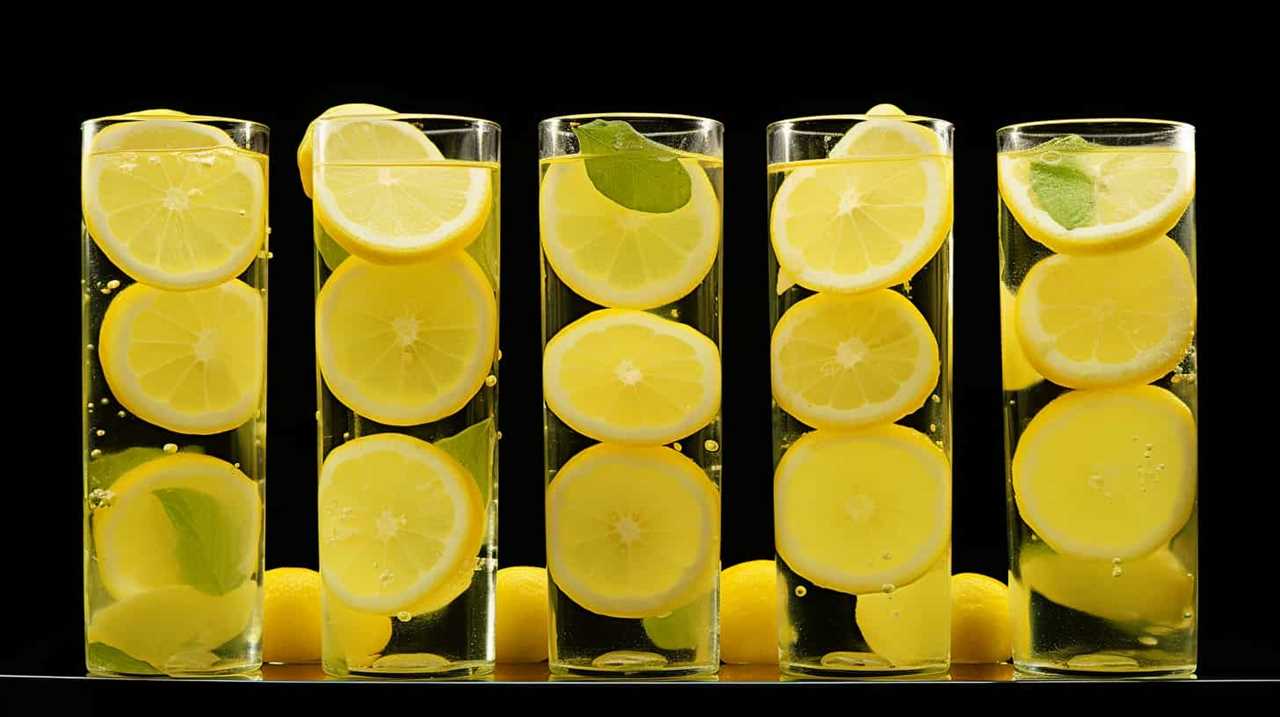
If we detect mold or growth in the orange juice, it’s a clear indication that it’s no longer safe to consume. By remaining vigilant and attuned to these indicators, we can ensure that our orange juice is always fresh and enjoyable.
Susannah expertise lies in researching and compiling evidence-based content on juicing, nutrition, and overall health. She is committed to ensuring that The Juicery World offers accurate, up-to-date, and trustworthy information to empower readers to take control of their health. Susannah’s goal is to inspire individuals to embrace juicing as a way to nourish their bodies and live their best lives.
-

 Juice Tips and Tricks3 months ago
Juice Tips and Tricks3 months agoHow Much Lemon Juice Is Equal To Half A Lemon
-

 Juice Tips and Tricks3 months ago
Juice Tips and Tricks3 months agoHow Much Lemon Juice Concentrate Equals One Lemon
-

 Juice Tips and Tricks3 months ago
Juice Tips and Tricks3 months agoHow Long Can You Drink Orange Juice After The Expiration Date
-

 Fruit Juice Varieties2 months ago
Fruit Juice Varieties2 months agoTop 11 Most Loved Fruit Juice Varieties
-

 Juice Tips and Tricks3 months ago
Juice Tips and Tricks3 months agoHow Much Lemon Juice Is Equivalent To 1 Lemon
-

 Organic and Natural Juices2 months ago
Organic and Natural Juices2 months ago8 Best Organic Brands for Fruit Juice
-

 Juice Tips and Tricks3 months ago
Juice Tips and Tricks3 months agoHow Much Lemon Juice Is Equivalent To One Lemon
-

 Juice Tips and Tricks3 months ago
Juice Tips and Tricks3 months agoHow Long Do You Need To Drink Pineapple Juice Before Oral



